The delicate but haunting imagery in Emily Tull’s portraits expertly depicts the fragility of life. Layers of fine fabric are embroidered over with a worn, frayed effect of sketchy stitching.
Her work “A Conversation with Death” was inspired by Shakespeare’s Hamlet, intertwined with the personal story of the portrait sitter. The subject matter guided her in the select of dark and sumptuous fabrics to layer up the piece.
She is obsessed with faces and how they show the passing of time, keen on showing the fragility of flesh through her thread colour choices and stitching. From her use of fabric layering and stitched mark-making, her work grows into semi-abstract faces with a sense of mystery hidden behind.
Emily Tull won the Visual Arts (Non-Digital) section of the Kent Creative Awards in 2017. She is a co-founder of the Society for Embroidered Work, which promotes contemporary stitch artists. She was a contestant on Sky Arts Portrait Of The Year (2014) and a finalist in the Winter Pride Art Awards (2016). She exhibits across the UK and internationally including at the Mall Galleries (2018), Royal Academy Summer Exhibition (2014) and the Ruth Borchard Self Portrait Prize Exhibition (2015).
In this interview, Emily shares how she designed and constructed “A Conversation with Death”. She gives an incredibly useful insight into how the initial choice of a subject guided her design composition. We’re shown how she builds up her work in layers, chooses fabrics and carefully positions the portrait’s elements in order to express a story of mortality and loss.
Name of piece: A Conversation with Death
Year of piece: 2015
Techniques and materials used: Hand-stitch, black cotton, flocked organza, velour, blue shirt, muslin and basic sewing threads
Size of piece: 2′ x 3′
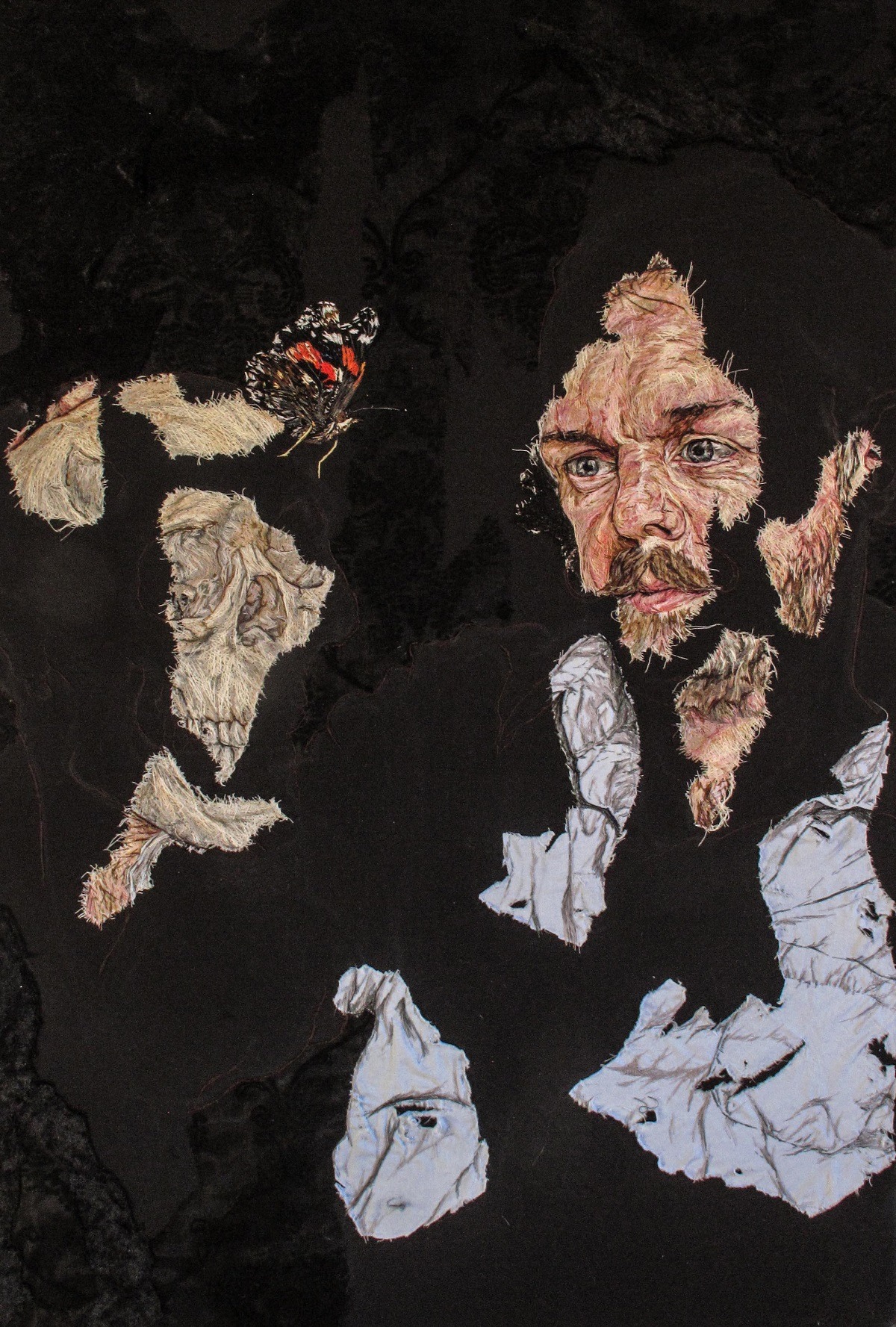
Exploring mortality and loss
TextileArtist.org: How did the idea for the piece come about? What was your inspiration?
Emily Tull: “A Conversation with Death” was made as part of a series of artworks inspired by Shakespeare’s Hamlet.
I had already created still-life pieces using symbols connected to the themes examined in the play. For example skulls and flowers, relating to Ophelia’s speech. And I’d used other symbols like tablecloths and butterflies, in reference to Vanitas-style paintings and mythology.
Moving on from these I wanted to do some figurative artworks taking on some of the famous parts of Hamlet.
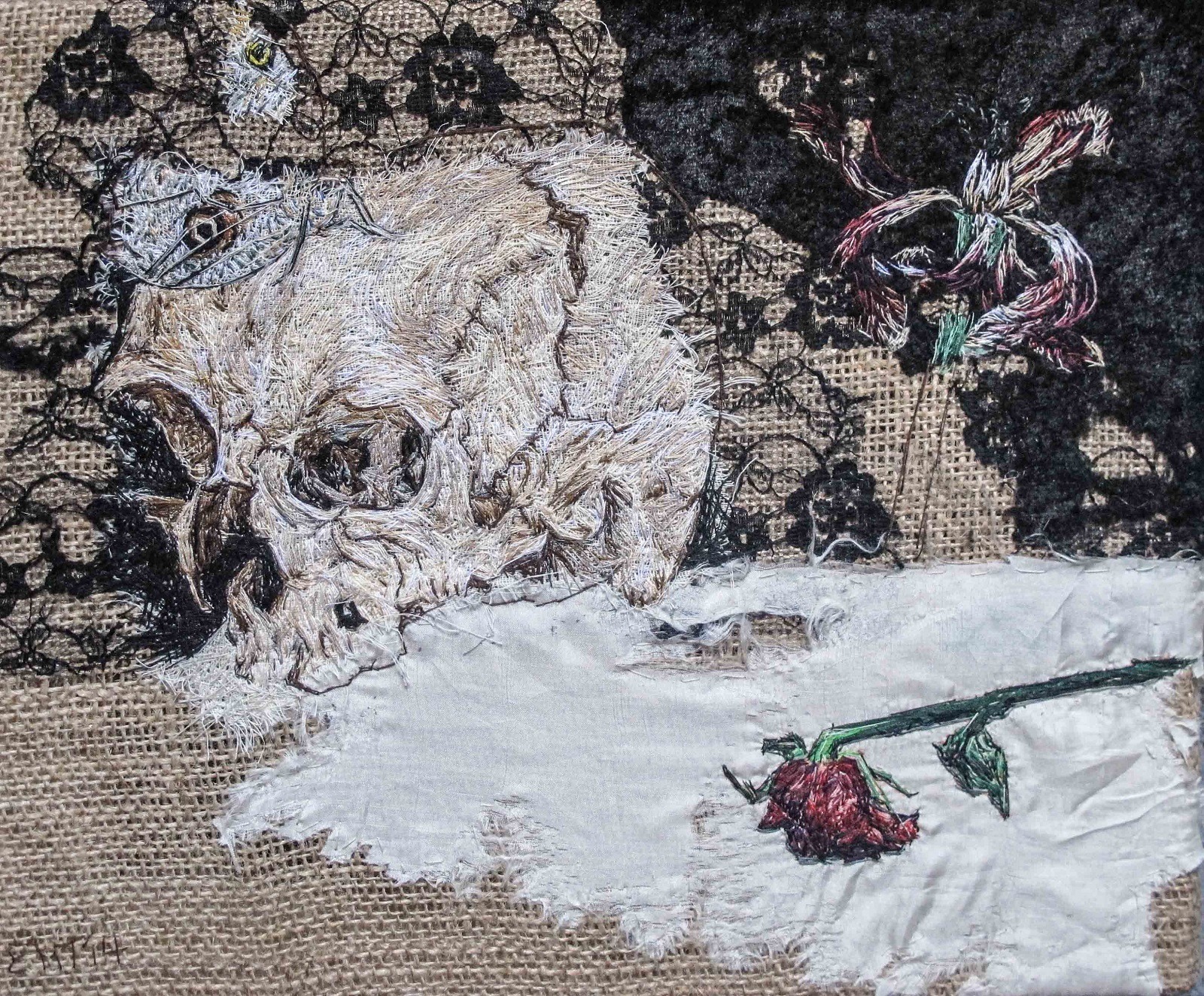
What research did you do before you started to make?
I don’t often do a lot of preparatory work as most of my compositions develop from the shapes formed from the ripped or broken materials I work with. But the composition was important and complex for this piece. It was going to be my first figurative piece including the head and body, going all the way down to the waist. I wanted to include other items within the portrait and attempt the iconic pose of Hamlet holding the skull while interweaving a personal story too.
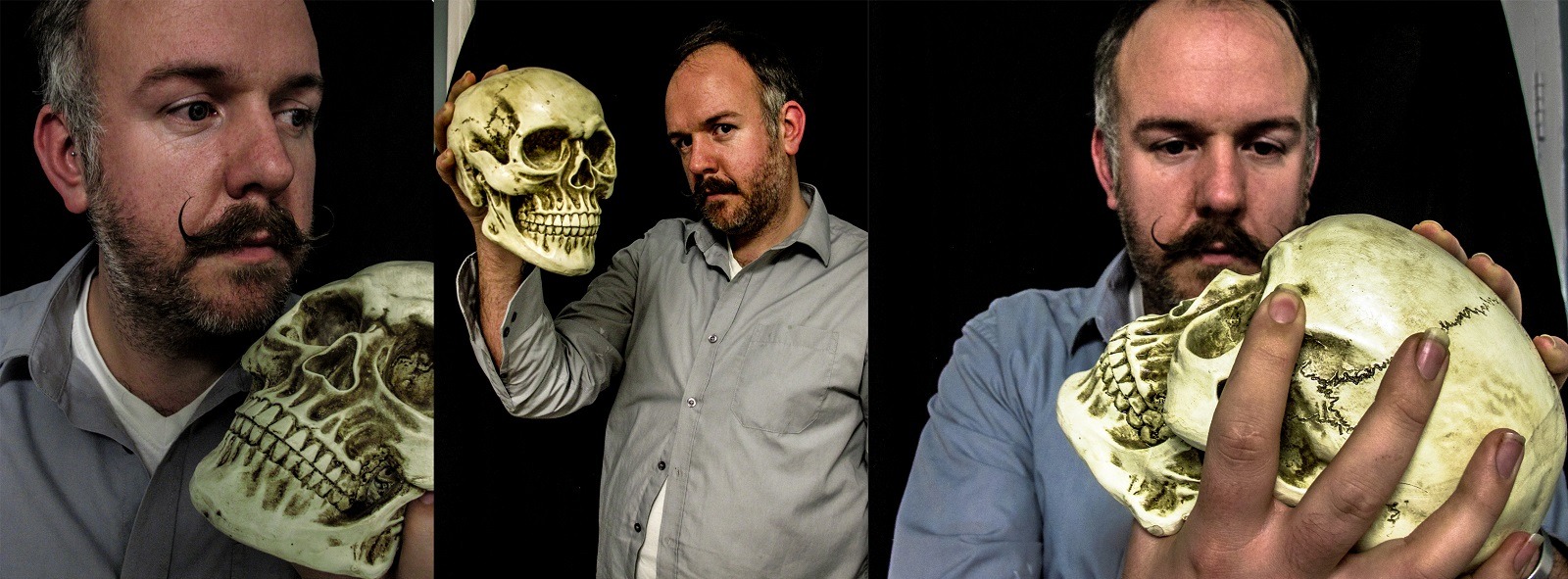
My very good friend and often-used model Ben was going to be my Hamlet. He was perfect for the part. I hope he doesn’t mind me saying this about his hair, but it was perfect! The hairline is receding and starting to grey, a sign of life and the ageing process. At the time he also had a twirly moustache, a hint of the past.
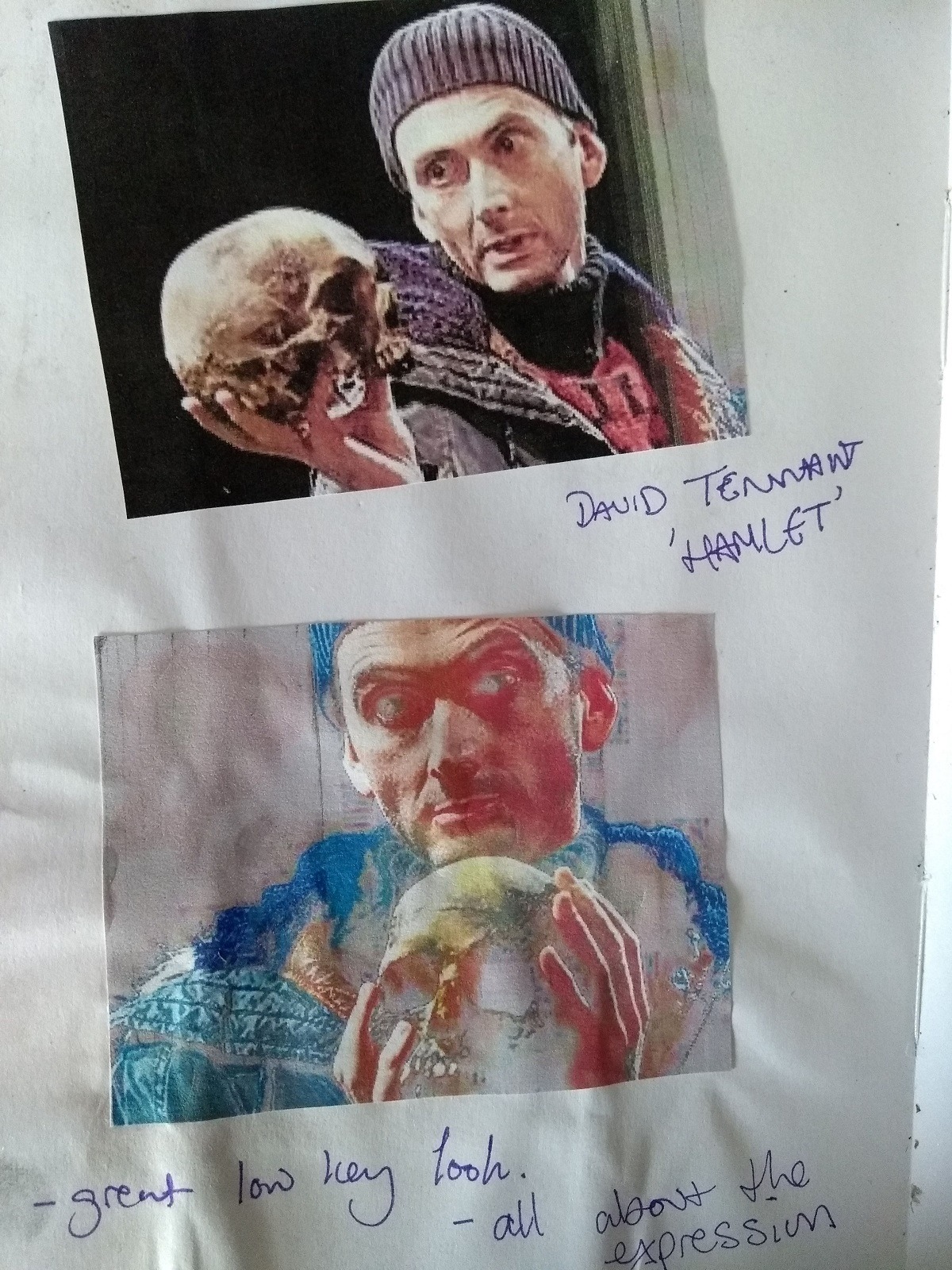
But before anything could be started I had to look into poses. The internet is a fantastic resource. I looked for photoshoots of different film and theatre productions and other fashion shoots inspired by the classic Hamlet pose. My sketchbook also gained a collection of more modern takes; Hamlet portrayed by David Tennant was a big motivation for me. In the play he’s wearing a woolly hat and parka coat.
I was also interested in how the skull was handled. I did numerous little sketches of how Ben could hold the skull. In the end, the best way to work out the pose was to have a photoshoot.
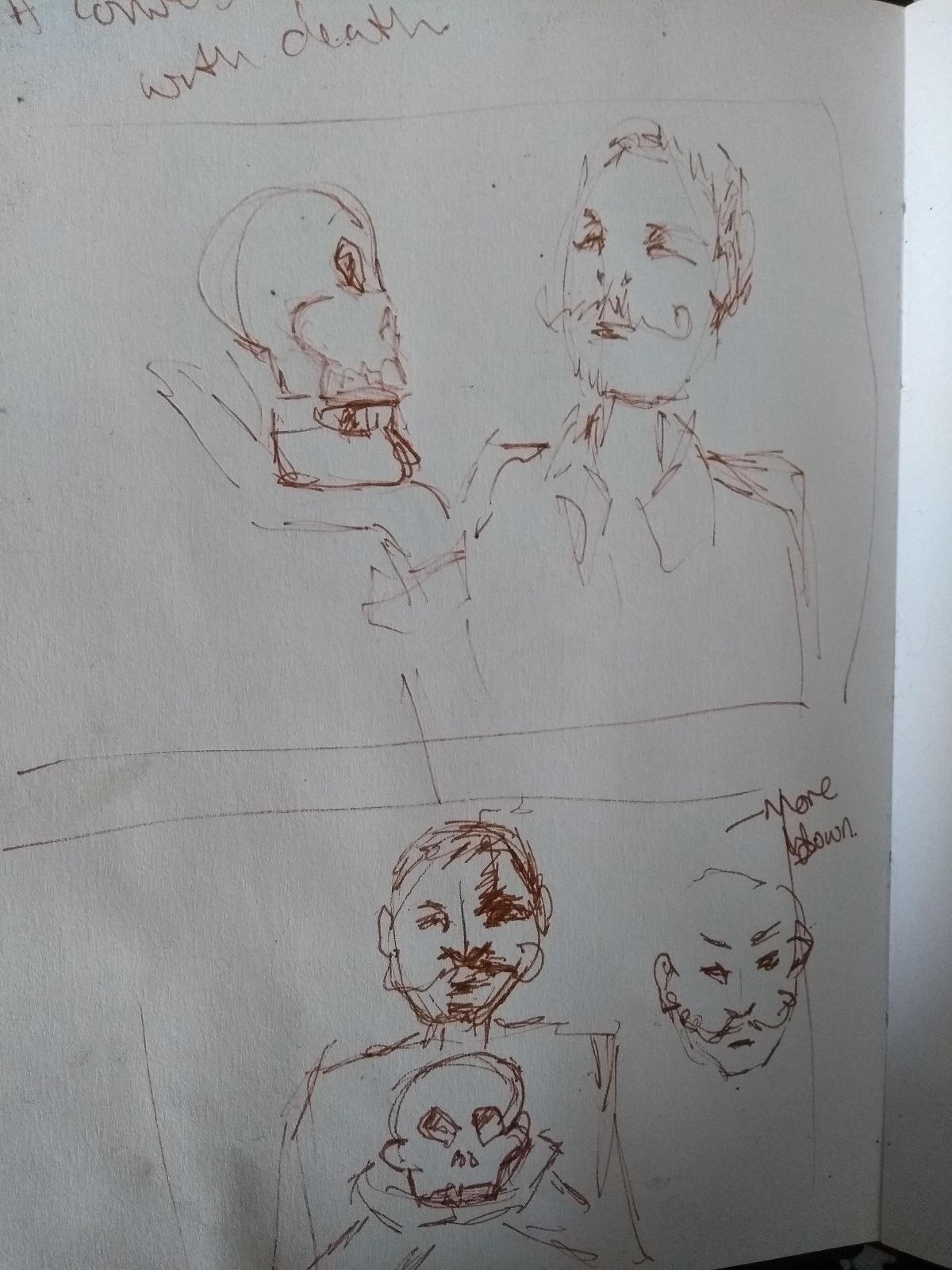
Dark and luxurious fabrics
Was there any other preparatory work?
The personal story that I wanted to include was the recent death of Ben’s grandmother. We had grown up together and were close. Ben and his family were happy for me to include the loss of his grandmother in my artwork.
They believed that the Red Admiral butterflies that kept appearing to them was her spirit and I really like that idea that our spirits stay around in different guises. There’s a comfort in that sense that someone is watching out for you.
Through my research, I found that some cultures believe that Red Admiral butterflies represent transformation and resurrection, or can be a symbol of the Angel Of Death.
Having established a pose for Ben, it guided the positioning of the butterfly. I wanted both the skull and the butterfly to be connected with Ben’s expression, showing conversations with death through the skull and the butterfly.
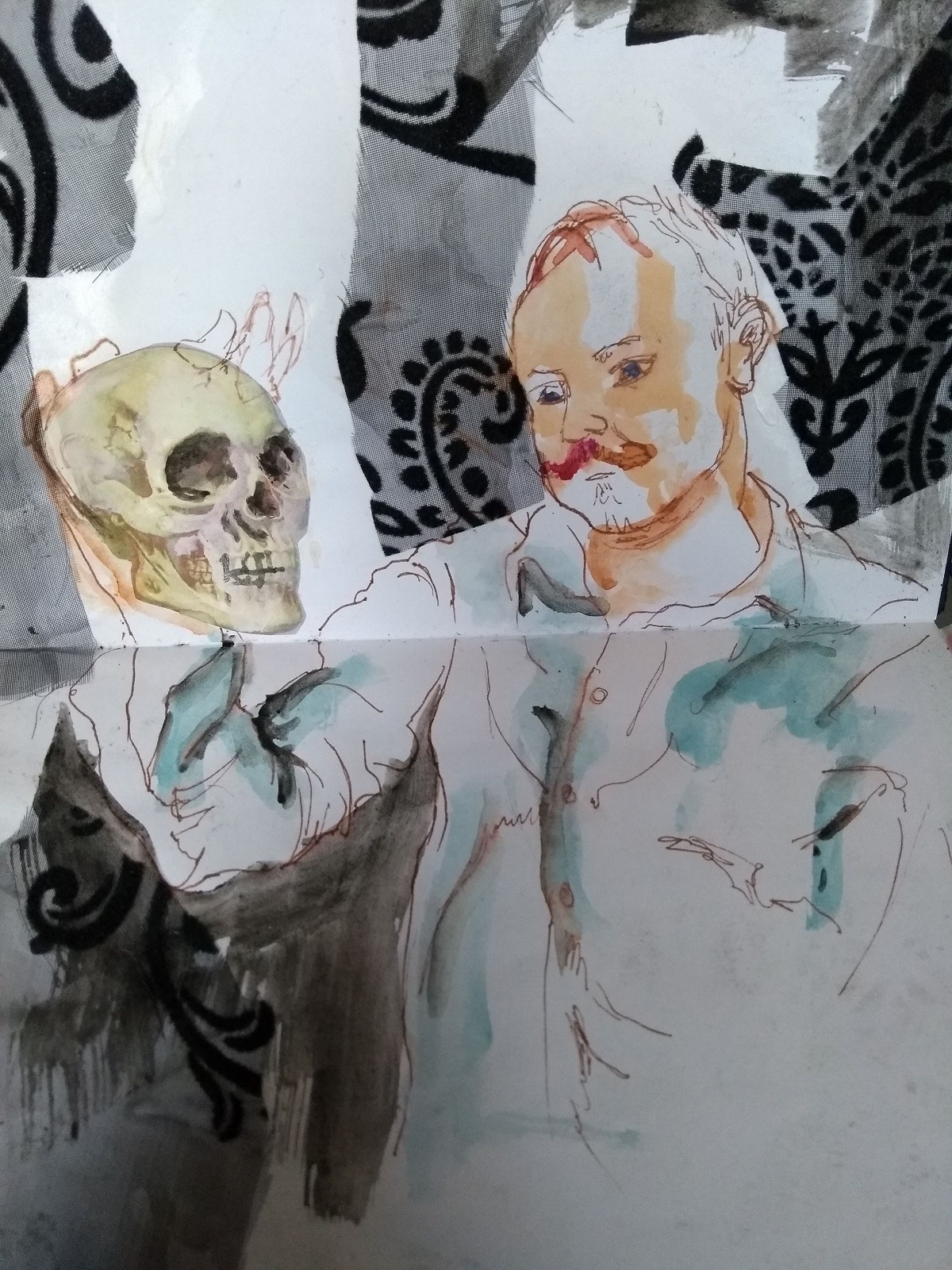
What materials were used in the creation of the piece? How did you select them? Where did you source them?
I always make a carefully considered choice of fabrics and materials for my artworks. They can play just as big a part in the narrative as the model. It was no different for this portrait.
I knew I wanted the background to be dark, to give focus on the characters but also a sense of isolation. I wanted it to be luxurious and not plain, hinting at the luxury of life.
The background is made up of three layers. The first is black cotton which gave me the base where I sketched out the pose using chalk. The second layer, black flocked organza, gave a subtleness to the cotton like a wallpaper. It reminded me of my great grandmother’s flocked wallpaper feature wall, which I adored. The third layer was black velour which appears on top of the organza, giving a further layer of luxury.
To be able to draw Ben’s face with more detail I used muslin as a ‘skin’ layer. This was thin enough not to be too bulky and it was easy to cut away. I used the same fabric for the skull.
For clothing, Ben is wearing a blue shirt. Death is a sentence we are all going to serve and we can be slaves to our work, so the choice of a blue shirt is a deliberate reference to a prison or workhouse. The fabric used for this was actually an old shirt of mine.
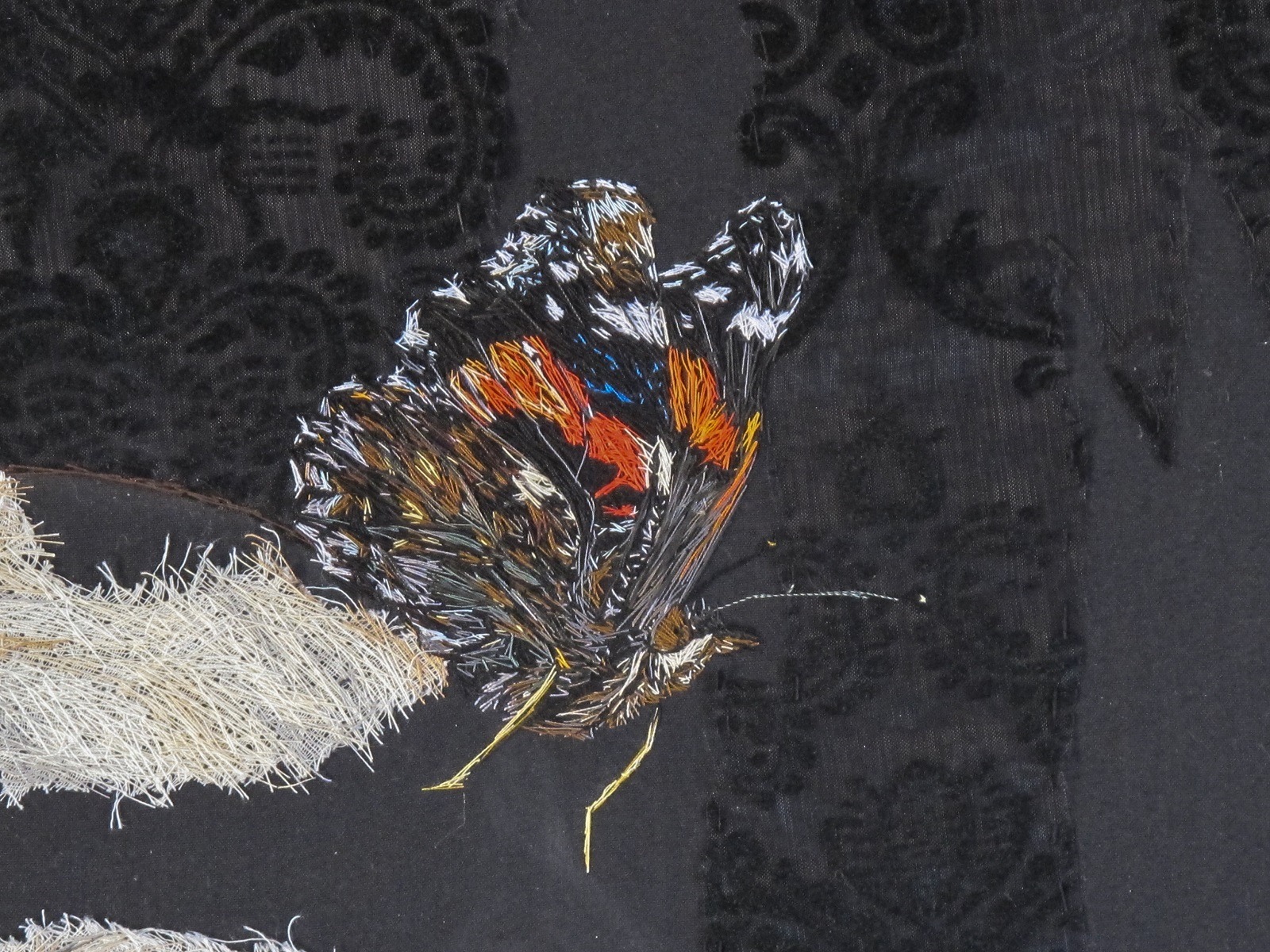
What equipment did you use in the creation of the piece and how was it used?
I work within a very simple set-up. It’s just me, my fabrics, a large wooden stretcher board (2′ x 3′) and my needle, plus a giant crate of sewing threads. The fabrics are stretched on and held in place with staples. I come from a painting background so this is how I’ve always prepared my artworks.
My stitching is all done by hand, in no particular style or technique. I am self-taught and go with what feels right.
The last bit of equipment I use is my laptop with the reference photograph zoomed in, to see the small details.
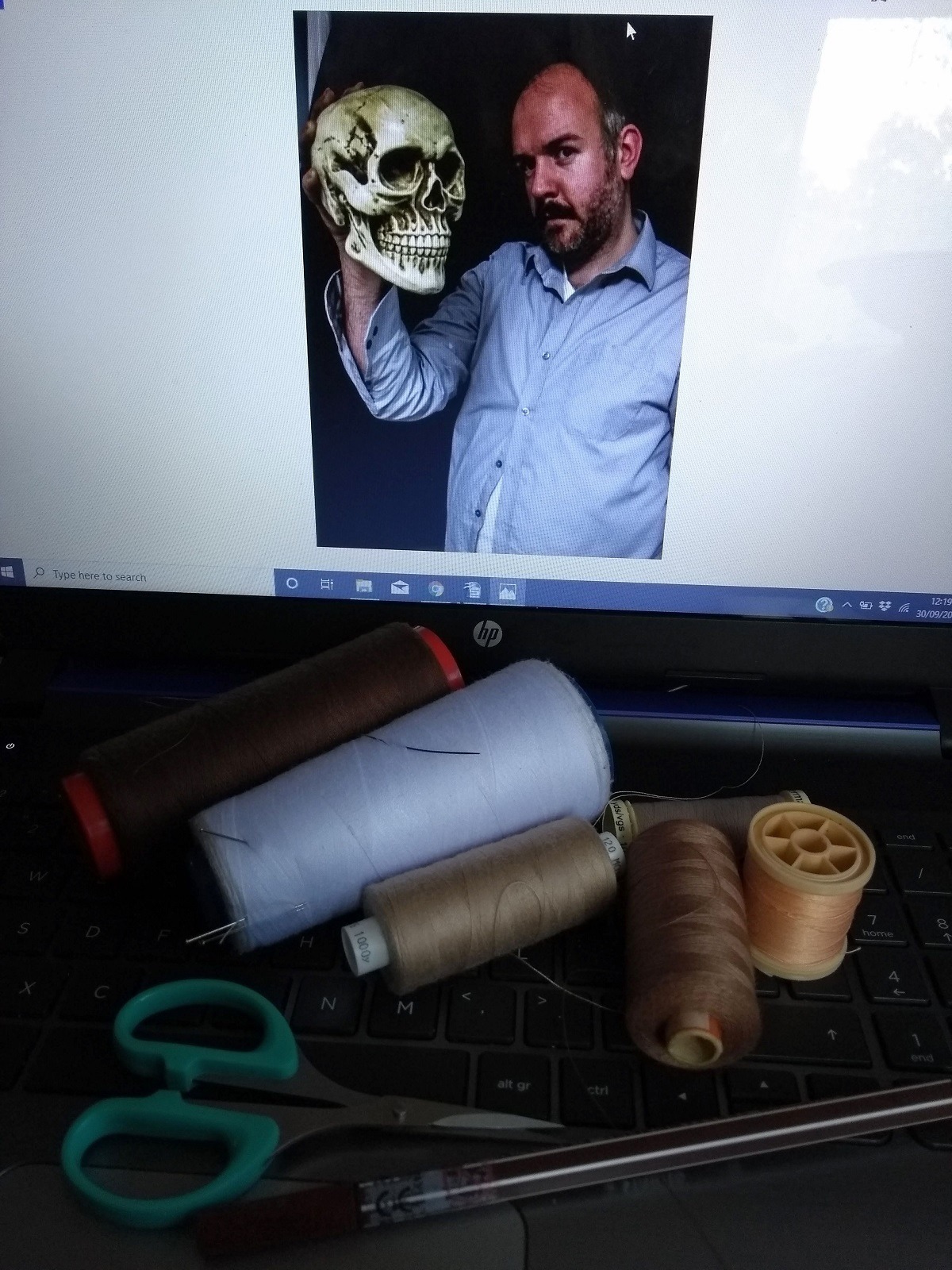
Tattered layers
Take us through the creation of the piece stage by stage
Before I start I switch on some music. For the mood of this piece, I chose classical music and Nick Cave!
A large piece of muslin was pinned on the board. I drew Ben‘s face with brown pen, then made any adjustments on top in black or blue.
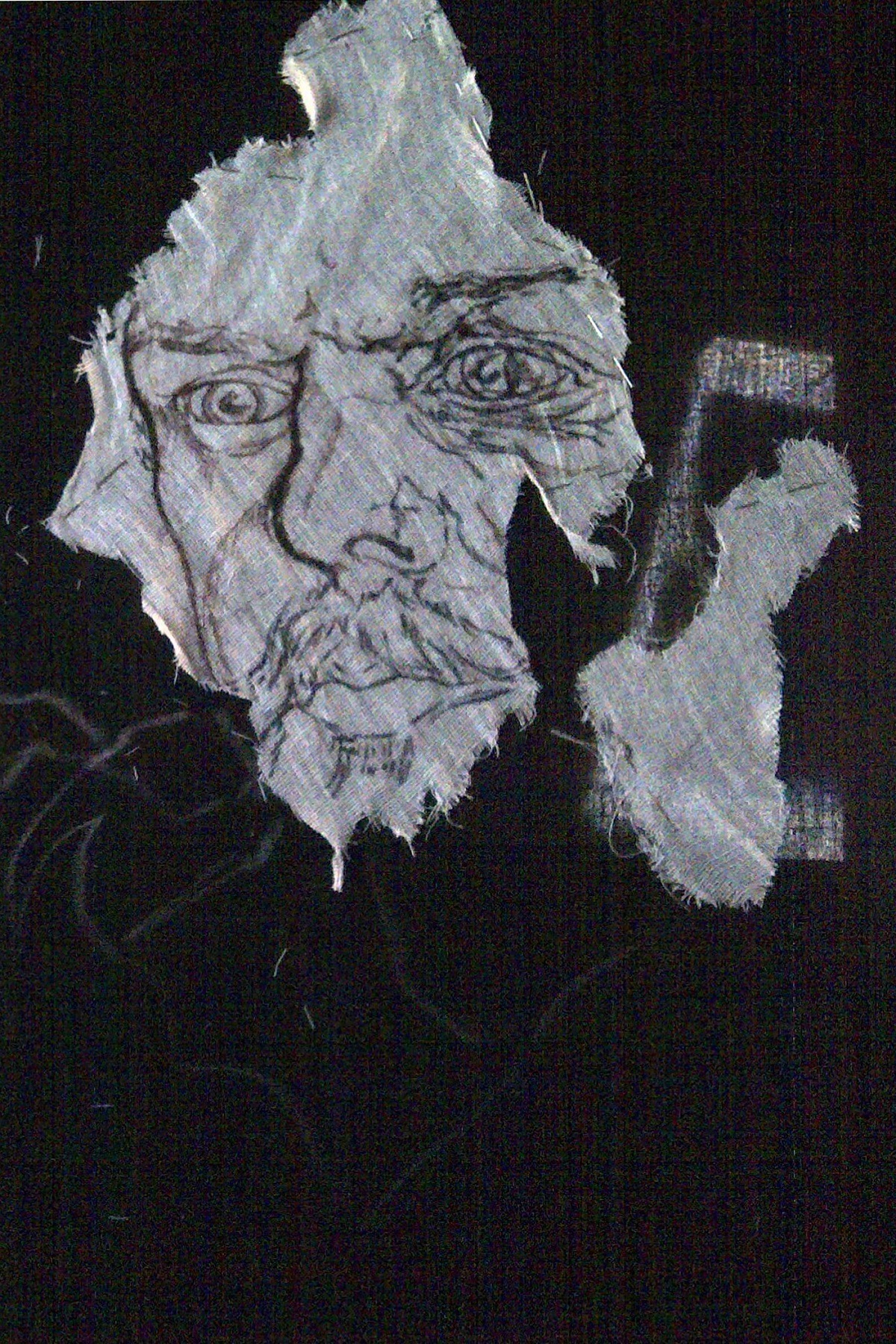
When I was happy with that I made a rough chalk drawing of the body and skull on black cotton, to get a sense of proportion. Then I started Ben’s face. For my portraits, I always stitch the eyes first and move out across the head. It’s an organic process.
I have a rough idea of what I want to stitch but I follow my instinct and the aesthetics of how it looks as it develops. I don’t produce a complete head or body portrait. The reasoning behind my abstract approach is that the fragmented shapes represent broken relics, whether be it Roman sculptures or ripped wallpaper. It is left to the viewer to complete the imagery.
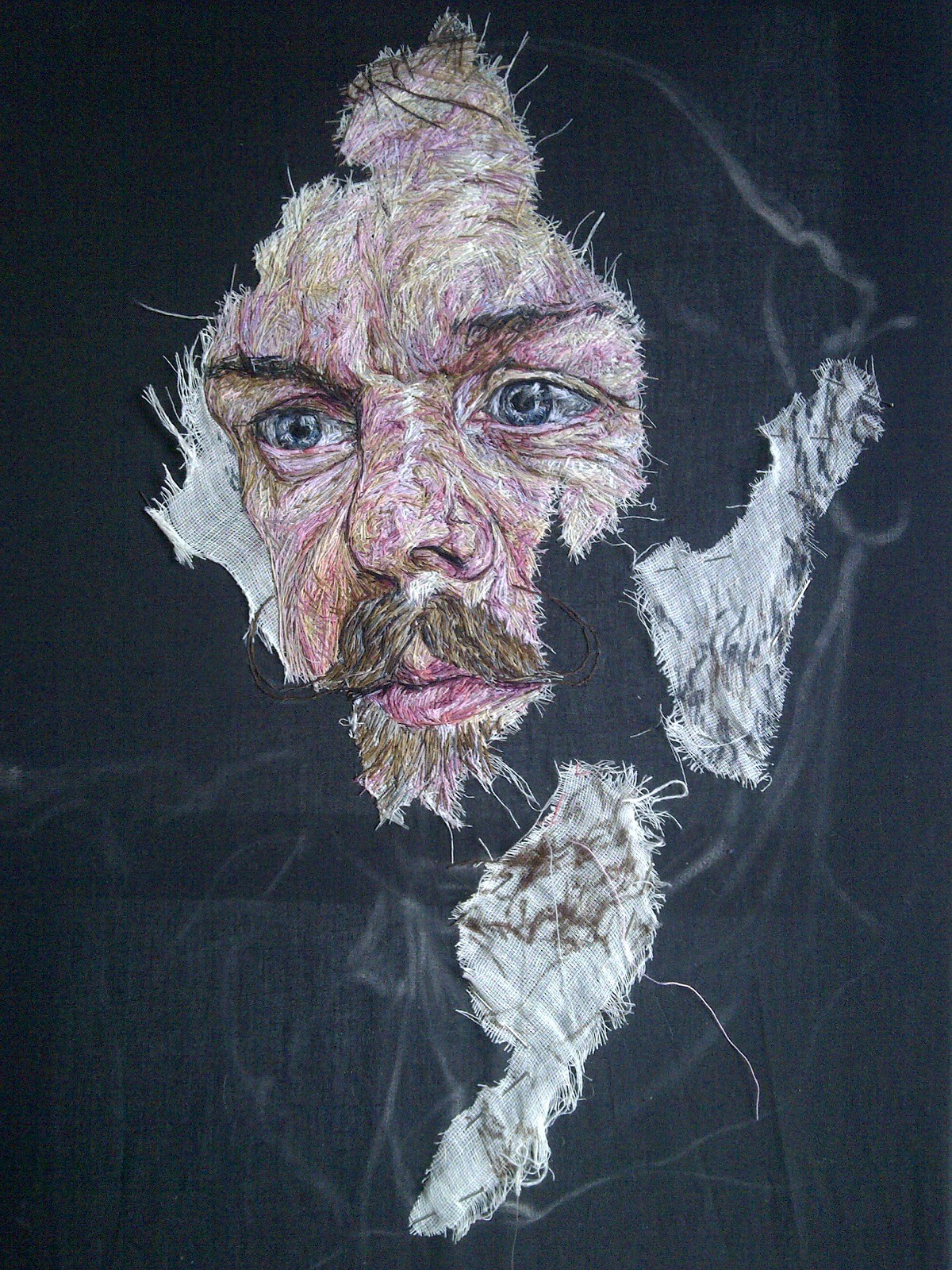
The muslin was cut away as I worked and some parts were redrawn, especially the chalk outlines because the proportions make more sense once the head is complete.
The shirt material was pinned in place and I start shredding it with sandpaper to give a worn feel. This section was quite simple to create. It was about cutting in the body outline and some basic stitching. Not too much stitching was needed due to the choice of material. I just created the creases and collar.
Next was the skull. I made this in the same way as Ben’s head, initially drawn with more detail on the muslin and then stitched. Again the starting point for stitching was the eye.
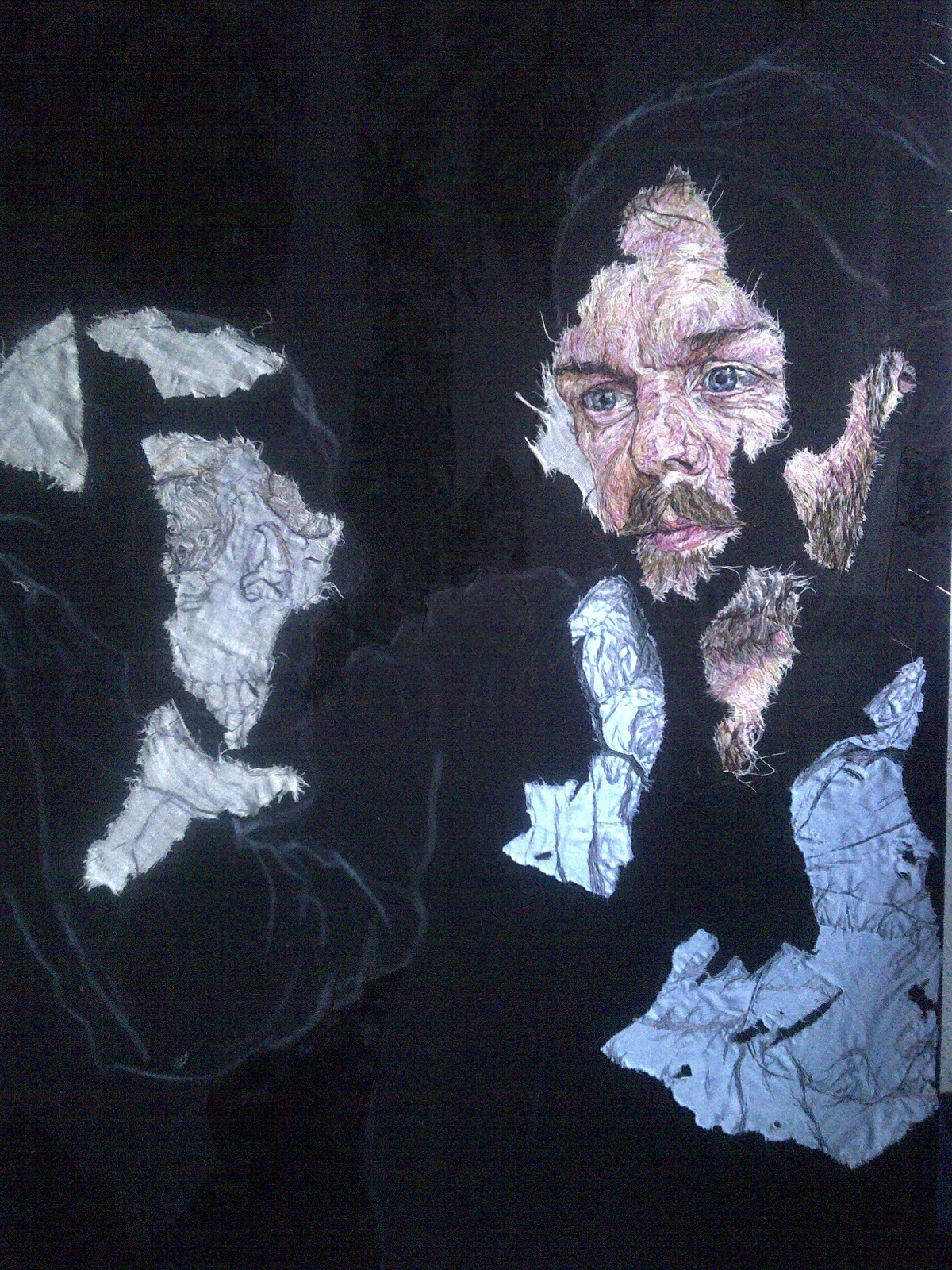
Then I drew in the butterfly with tailor’s chalk pencil. Most of the detail is covered up with my stitching. I decided against drawing it on a different fabric first and pinning it in place as I thought that would be too fiddly.
Last, of all I created the background, using the flocked organza first. This was used as an aid to help outline the parts of Ben which had been cut away. First I pinned and tacked it in place, then the layer of velour followed. The velour and organza represent the layers of life and were torn and sand-papered to hint at decay.
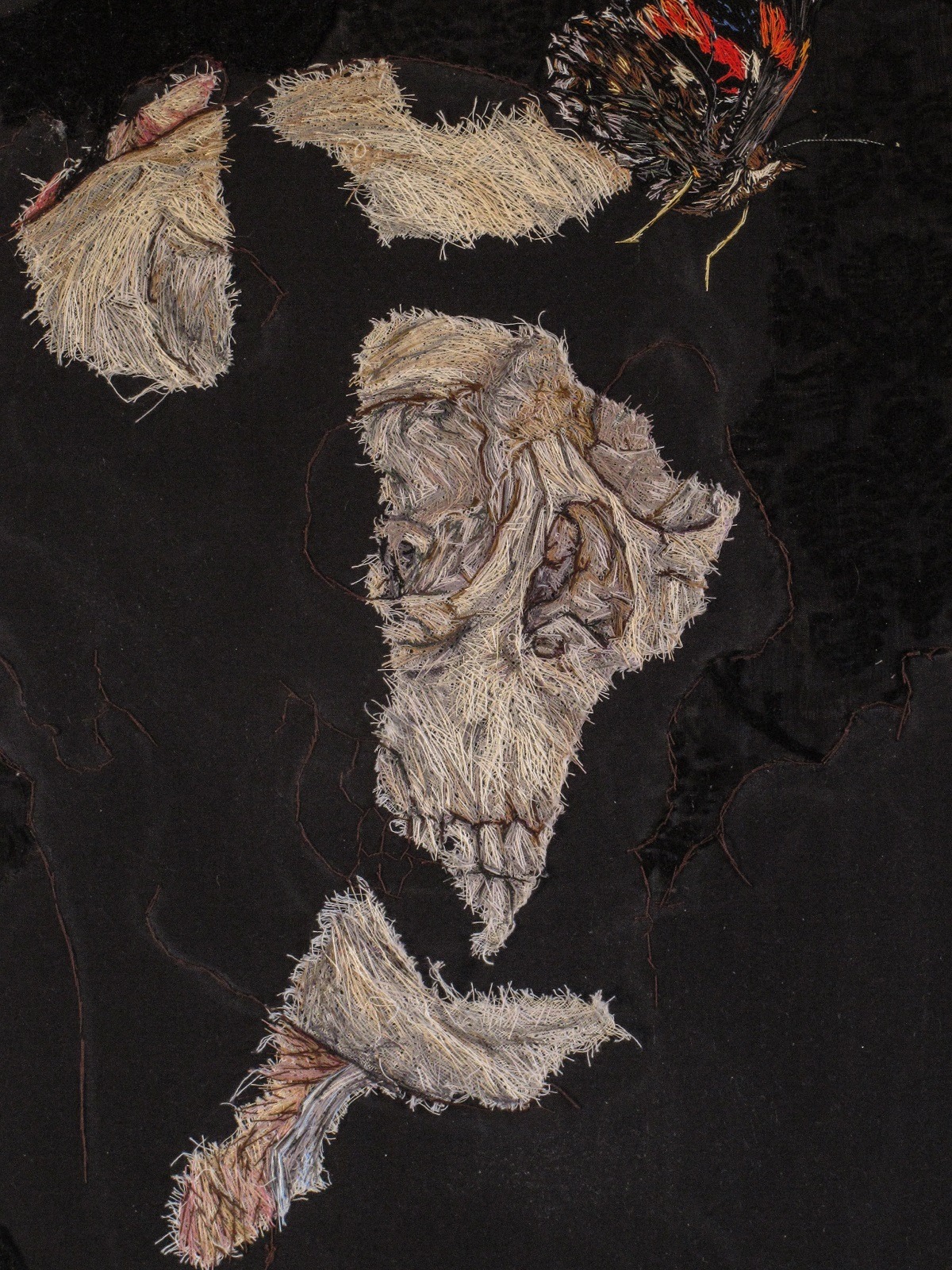
What journey has the piece been on since its creation?
Not long after its creation, the portrait was selected for the Islington Arts Factory Summer Exhibition and it has been shown in other exhibitions since. Notably, it also made the shortlist for the Visual Arts Open awards in 2017.
The most important journey for this portrait was its first viewing to Ben and his family. It’s always nerve-wracking when a model meets their stitched self! You are never sure who is more nervous, myself or them! The reaction was brilliant though. There were happy tears all round.
I am so pleased they understood what I was trying to say, at a time when their emotions of loss were still pretty raw.
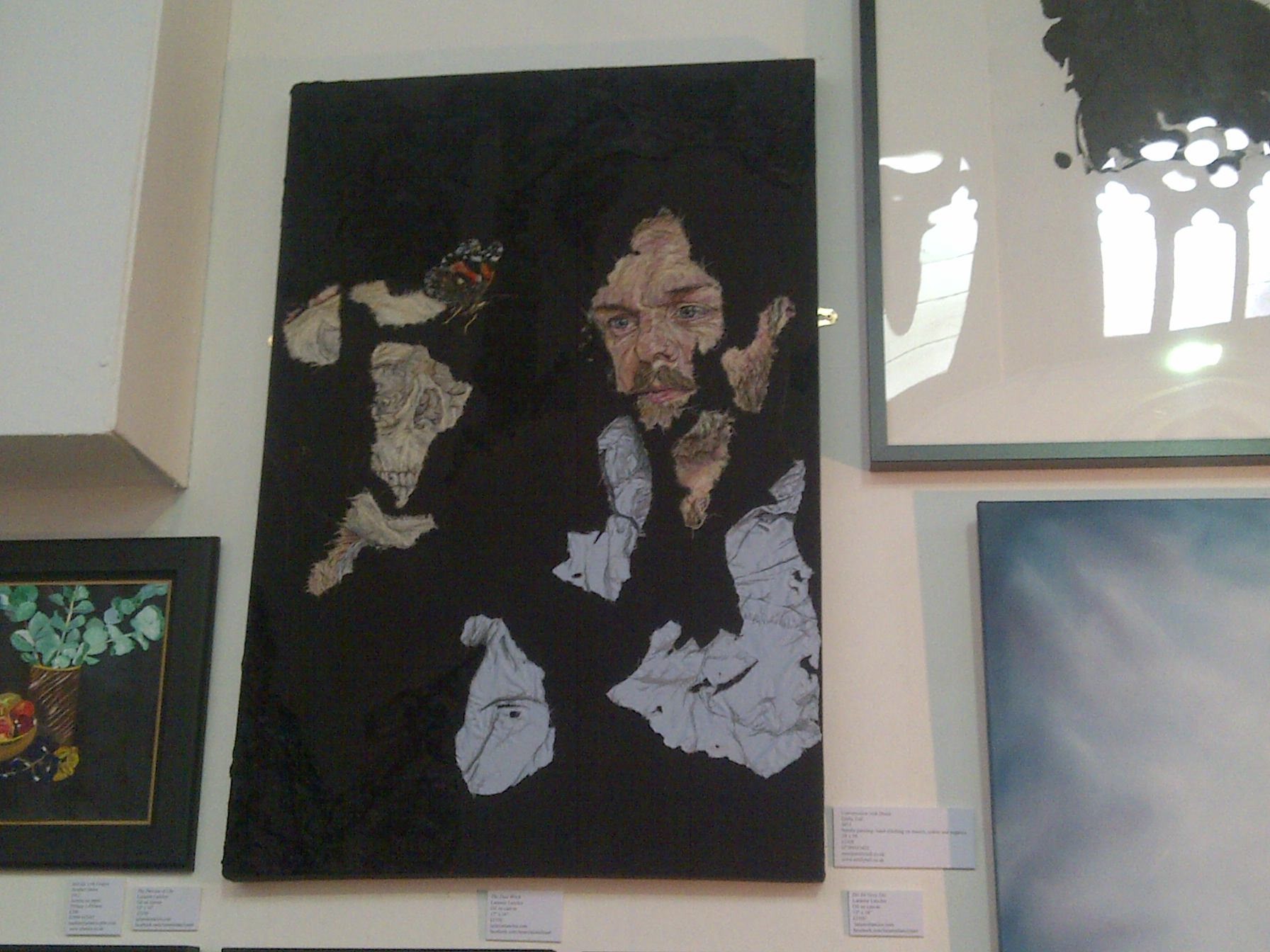
For more information visit www.emilytull.co.uk
Intrigued by Emily’s use of fabric layers and frayed effects? Let us know by leaving a comment below
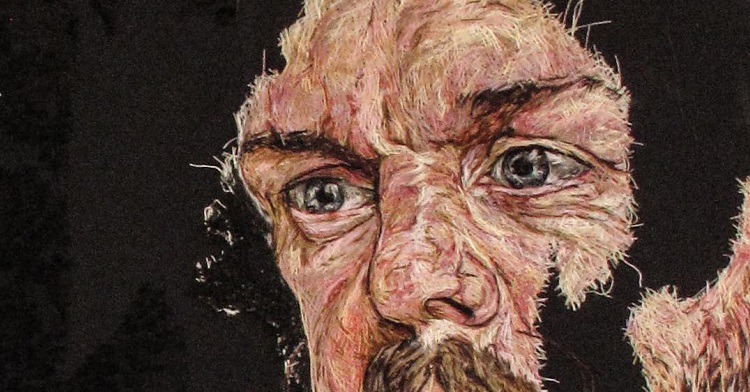

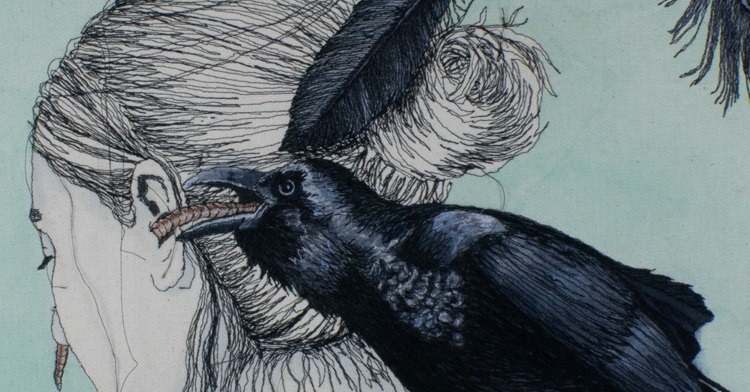
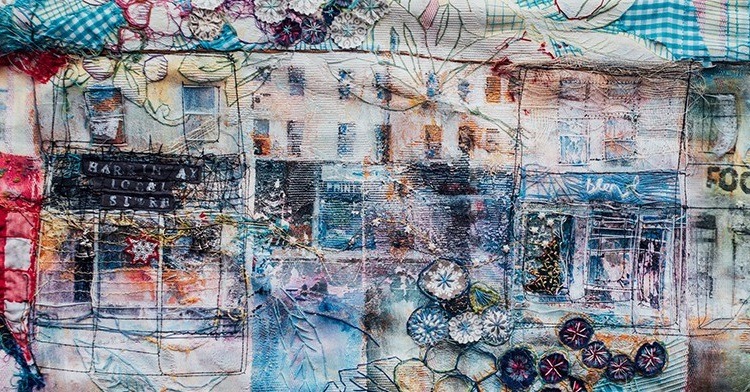
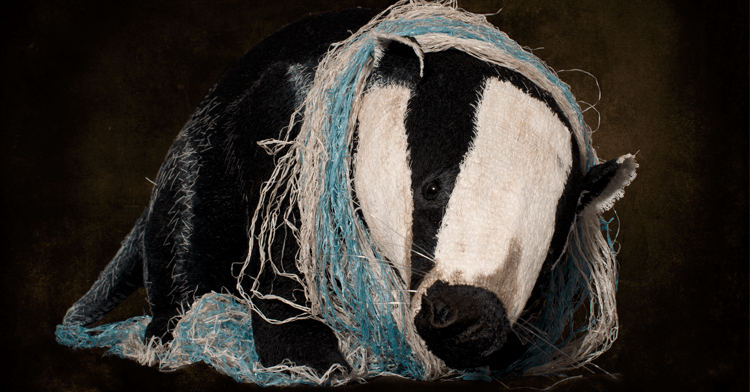
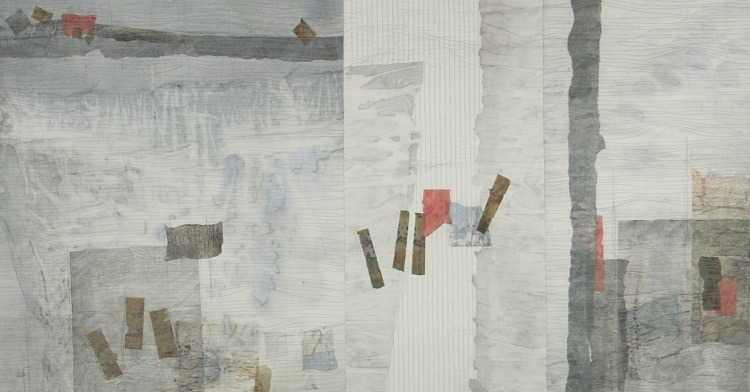
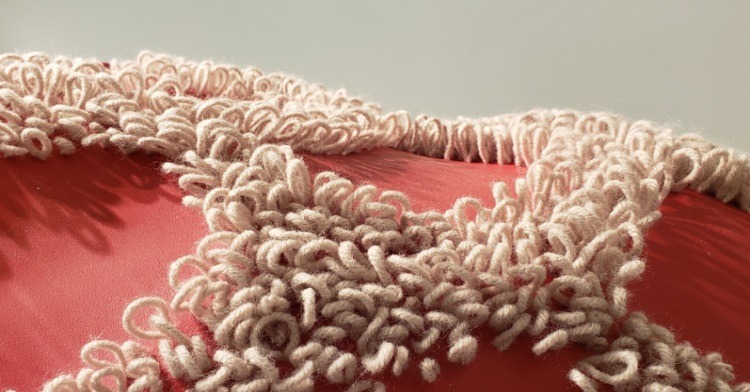
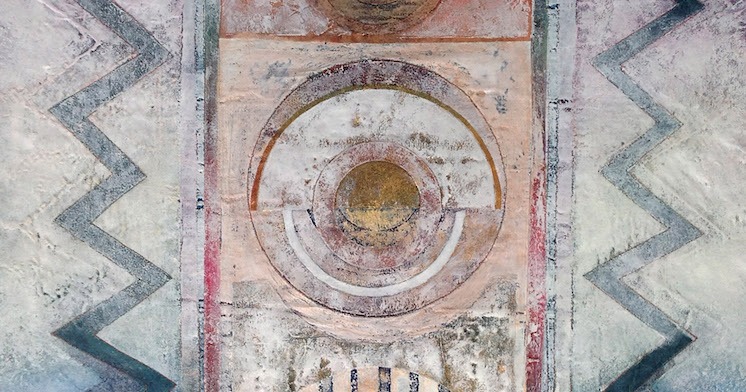
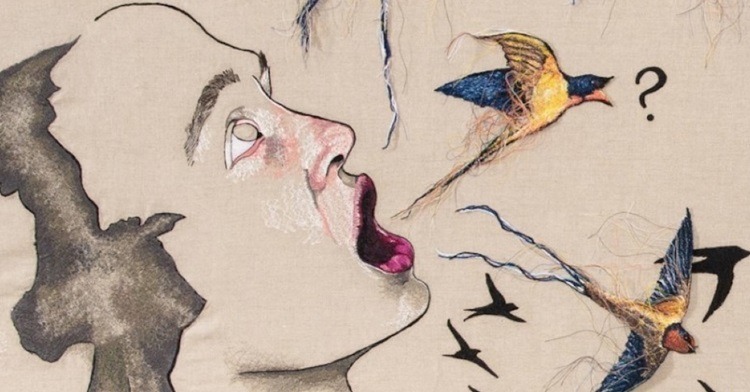
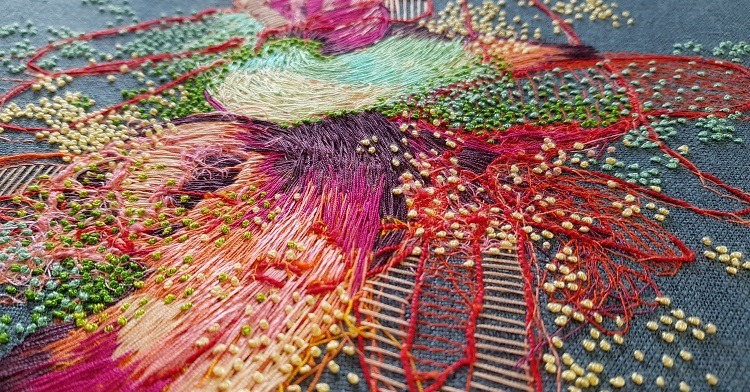
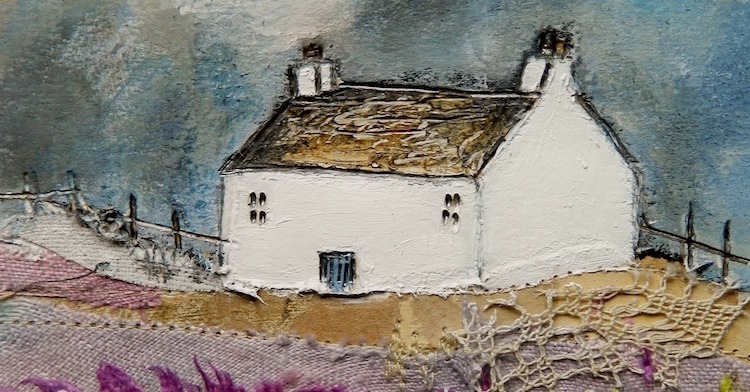
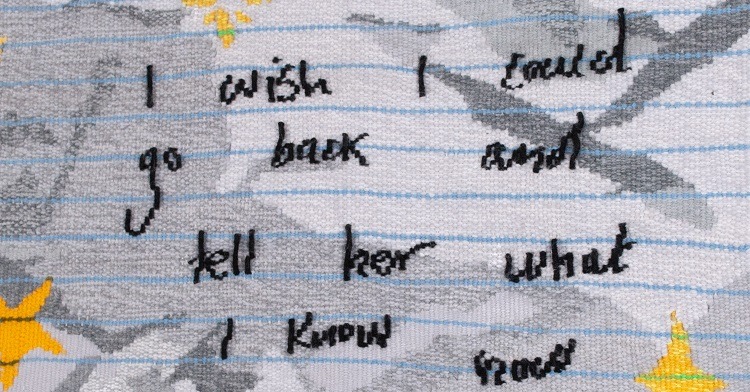
8 comments
Dr.Jaspals
Beautiful and meaningful.. use of drawing and intimate play of threads are wonderful and colorful.. is there whole art work on paper as background material.. aesthetically rich experience.. regards
Mary Chidlow
Thank you Emily Tull for your generosity in sharing your thought processes and techniques . The figurative and semi abstract content work so well in this contemporary work . Textile Arts – you have excelled yourselves with this article !
Lyn Crutchley
Thank you for generously sharing your technique and ideas. I agree this weeks challenge has been outstanding and so creative. I like the way you gave us some information at the start about how to compose the eye. We then had the week to explore our own technique and materials by really ‘looking’ at our subject and gesturally draw with a needle and thread. I have always believed that drawing and stitching go hand in hand! I have learnt SO MUCH this week.
We’ve been in CV lockdown all week so an ideal time to explore, to draw, to really LOOK, and then to stitch.
Carolyn Hayward
Thank-you so much for including Emily Tull in your reporting–I always enjoy seeing how an artist thoughtfully progresses through an art piece, from conception to final entry piece–although it might be finished for now it is never the end..
process and technique are always a boost to your own creative journey.
Linda Carswell
It’s always interesting to hear how others approach their work and I shall try the sandpaper effect!
Beth Miller
Thank you for your informative textile articles. I always enjoy reading then.
I will look forward to receiving “textileartist in the new year.
Best wishes for the festive season.
Beth
Alice
So interesting to see more of this artist’s work and methods having seen her working in the Sky portrait artist competition. The time constraints of the competition didn’t allow the full depth of the work to be seen, despite that what was achieved was very impressive and fascinating.
Carol-Ann Stiekema
mesmerising … thank you for sharing. Does the artist use single or dpuble thread?